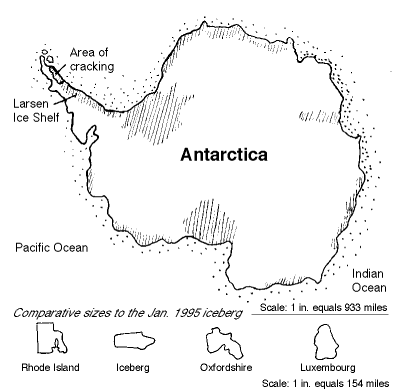Stunning news from Antarctica arrived last month just before the world’s nations gathered in Berlin to discuss global climate change. It was as if the South Pole had reared its hoary head again, as it did 10 years ago, to galvanize an international agreement.
What happened 10 years ago was the discovery of the enormous ozone hole. That news stopped political dithering about CFCs, the chlorine-containing chemicals that were known to eat up stratospheric ozone. Within two years, by 1987, 120 nations had pledged to cut their production of CFCs. In 1990 the agreement was strengthened to phase out CFCs entirely. In 1992 the phase-out date was moved back from 2000 to 1996, and as of 1994, global CFC production had been cut by 75 percent, at far less cost and with much less industrial disruption than had been predicted. The ozone layer is expected to go on thinning until the year 2000 and then start healing itself.
State-Sized Icebergs
Now, in the spring of 1995, the news from Antarctica is not about holes but cracks. The average summer temperature there has risen by almost 4 degrees F., and the massive ice shelves, hundreds of feet thick, that surround the continent are breaking up, sending off icebergs the size of Rhode Island (or Luxembourg or Oxfordshire, depending on which country’s newspapers you read).

The ice breaks are only the most recent and spectacular of many signals of global warming. Since 1880, when reliable measurements began, the warmest year on record was 1990, the second warmest was 1988, and 1994 just tied with 1987 for third/fourth. Ecologists are documenting the northward movement of species in Monterey Bay, California, in northern Michigan, in Alaska. In Antarctica not only is the ice cracking, but the two tiny kinds of flowering plants that manage to live there have suddenly started to spread vigorously.
Wild Weather
In the US Midwest, the average temperature has gone up and the average precipitation down over the past 95 years. Winter snow cover in the northern hemisphere has been receding since 1972. Glaciers are shrinking everywhere. The El Nino weather that recently drenched California is coming more frequently and severely; it arises from hot spots in the Pacific Ocean. Planet-wide weather is getting so wild that some insurance companies have stopped covering climate-related disasters.
Just as 10 years ago we knew what was eroding the ozone, so we know now what is warming the climate. It is the accumulation of greenhouse gases in the atmosphere, most especially the carbon dioxide released when we burn oil, coal, and gas. As was true with regard to ozone 10 years ago, we know what to do, and just as back then, we are having trouble agreeing to do it.
In 1992 at Rio, the 18 most industrial nations (and biggest carbon dioxide emitters) agreed to enter the year 2000 with their carbon emissions no higher than they were in 1990. That would by no means be enough to stop the buildup of greenhouse gases – scientists figure we’d need a 60-80 percent reduction in fossil-fuel burning worldwide to do that. But it would be a step in the right direction.
So far only four of those nations (Denmark, Germany, Norway, and Great Britain) have produced plausible plans for how to achieve that minimal goal. The others, including the US, not only have no workable plans, but their emissions are continuing to go up.
Poor Nations Push Cuts
So, with the ice sheets cracking, the nations came together in Berlin. The big push there came from the poor nations, who argued that the rich ones, which have produced most of the warming gases so far, ought to make most of the cuts. India and an alliance of 38 small island states (which could virtually disappear under a warming, rising ocean) asked the industrial states to reduce their carbon emissions by 20 percent by the year 2005.
Some rich nations, mainly in Europe, considered a 20 percent reduction a reasonable goal, which could be accomplished by simple energy efficiency technologies. But they worried about the burgeoning populations and economies of Asia and Latin America. Without similar efficiency measures, they will quickly undo whatever cuts the rich countries make.
The oil-exporting Middle East was in favor of everyone burning as much petroleum as they like. China, with huge coal reserves, refused to take any responsibility. The US, trying to balance its environmentalists, its powerful oil and coal companies, and its right-wing ideologists who deny that there’s any problem, waffled.
Back to the Drawing Board
That was the essence of the global discussion. On April 7 everyone went home, having declared a "Berlin Mandate" – that by 1997 they will come up with a concrete, time-targeted plan. You could say that was a non-happening.
But if the agreement they come back with in 1997 has any teeth at all, even if there are not enough teeth to bite off the whole problem, it will follow the 10-years-earlier ozone story exactly on schedule. It will spur enough forward movement that perhaps we will learn, as we did with CFCs, that in fact we can cut back on fossil fuel consumption at far less cost and with much less industrial disruption than is being predicted.
Donella H. Meadows, co-author of Limits to Growth and Beyond the Limits, is an adjunct professor of environmental studies at Dartmouth College and an IC contributing editor.






